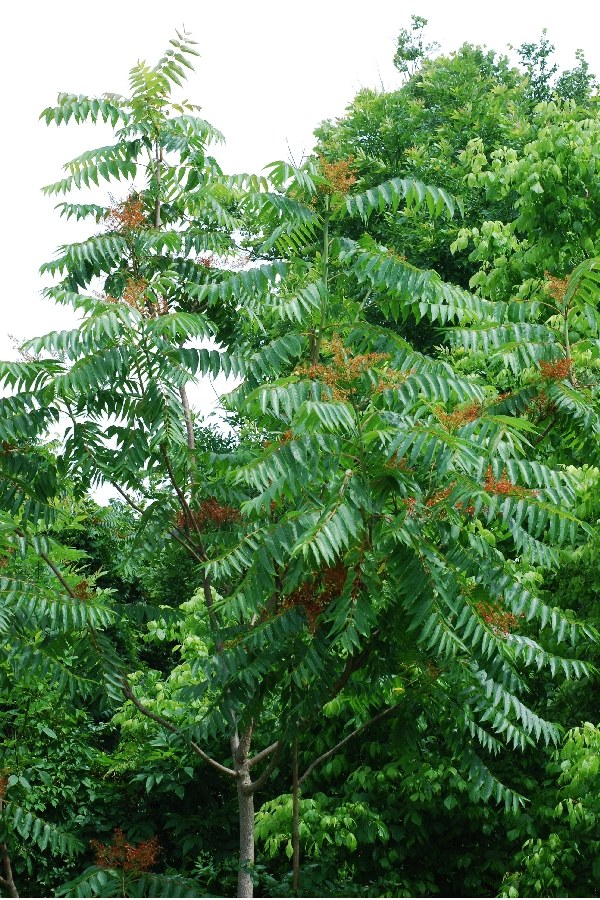Posted: May 10, 2023

Tree-of-Heaven from USDA-NRCS PLANTS Database
Tree-of-heaven (Ailanthus altissima), commonly referred to as ailanthus, is an invasive plant commonly found in Pennsylvania—and it is a preferred food source of the invasive, destructive spotted lanternfly. Controlling tree-of-heaven is important in the work to control the spotted lanternfly.
Tree-of-heaven is a rapidly growing deciduous tree native to both northeast and central China, as well as Taiwan. It was first introduced into the United States in the Philadelphia area in the late 1700s.
The tree was initially valued as a unique, fast-growing ornamental shade tree with the ability to grow on a wide range of site conditions. It was widely planted from New York City to Washington, D.C. By the early 1900s the tree began losing popularity due to its "weedy" nature, prolific root sprouting, and foul odor. Tree-of-heaven has spread and become a common invasive plant in urban, agricultural, and forested areas.
Due to its extensive root system and resprouting ability, tree-of-heaven is difficult to control. Treatment timing and following up the second year are critical to success. Mechanical methods, such as cutting or mowing, are ineffective, as the tree responds by producing large numbers of stump sprouts and root suckers. When cutting tree-of-heaven is necessary to remove potentially hazardous trees, it is best to treat with an herbicide first, wait for symptoms to develop (approximately 30 days), and then cut.
Hand pulling young seedlings is effective when the soil is moist and the entire root system is removed. Small root fragments can generate new shoots. Seedlings can be easily confused with root suckers, which are nearly impossible to pull by hand.
To control tree-of-heaven, target the roots with systemic herbicides applied in mid- to late summer (July to onset of fall color) when the tree is moving carbohydrates to the roots. Herbicide applications made outside this late growing season window will only injure aboveground growth. Following treatment, repeated site monitoring for signs of regrowth is critical to prevent reinfestation.
There are many effective herbicides available for use on tree-of-heaven. Herbicides applied to foliage, bark, or cuts on the stem are effective at controlling tree-of-heaven. Cut stump herbicide applications do not prevent root suckering and should not be utilized.
Foliar herbicide sprays are used where tree height and distribution allow effective coverage without unacceptable contact with nearby desirable plants. Treatments are applied in mid- to late growing season with equipment ranging from high-volume truck-mounted sprayers to low-volume backpack sprayers.
For dense or extensive infestations, treat initially with a foliar application to eliminate the small, low growth. Then follow up with a bark or hack-and-squirt application on the remaining larger stems.
Basal bark applications provide a target-specific method for treating tree-of-heaven that are generally less than 6 inches in basal diameter. Using a low-volume backpack sprayer, a concentrated mixture of herbicide containing the ester formulation of triclopyr in oil is applied from the ground line to a height of 12 to 18 inches, completely around the stem. To maximize translocation to the roots, apply herbicides from mid- to late summer.
Hack-and-squirt herbicide applications are highly selective with a concentrated herbicide solution applied to downward-angled cuts in the stem. For effective hack-and-squirt applications, apply to cuts spaced evenly around the stem. Leaving uncut living tissue between the hacks allows the herbicide to move to the roots. Again, apply in mid- to late summer.
Well-established tree-of-heaven stands are only eliminated through repeated efforts and monitoring. Initial treatments often only reduce the root systems, making follow-up measures necessary. Persistence is the key to success.
Excerpts from Tree-of-heaven Invasive Weeds Fact Sheet, Penn State Extension. Full article at extension.psu.edu/tree-of-heaven.
James C. Finley Center for Private Forests
Address
416 Forest Resources BuildingUniversity Park, PA 16802
- Email PrivateForests@psu.edu
- Office 814-863-0401
- Fax 814-865-6275
James C. Finley Center for Private Forests
Address
416 Forest Resources BuildingUniversity Park, PA 16802
- Email PrivateForests@psu.edu
- Office 814-863-0401
- Fax 814-865-6275

